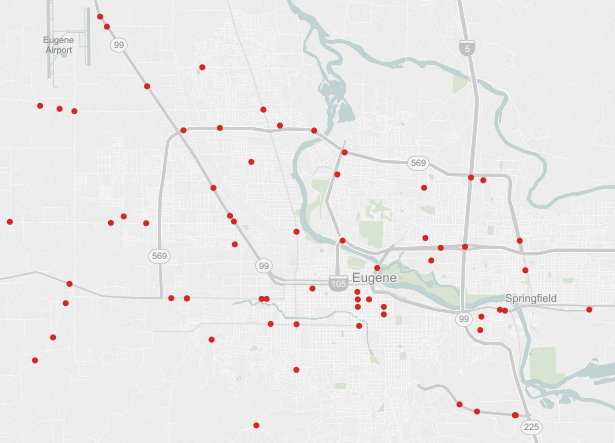Safer Streets for Everyone!
UPDATE 7/31/2016: Amend language of petition to call for pursuing the “9 Components of a Strong Vision Zero Commitment.”
UPDATE 4/24/2016: Now that the Eugene City Council has adopted Vision Zero with Resolution No. 5143, amend language of petition to address other local elected officials.
Pledge
- I will behave safely and responsibly at all times on public streets, respecting and empathizing with other people’s need to get where they’re going safely.
- I acknowledge that traveling on public streets can be risky, and I resolve to be alert to the surroundings.
- I also recognize the role of the roadways, paths, and sidewalks as public space in the community, not only a means for travel, and resolve to share the road with all users, whether they are traveling to a destination or enjoying the street appropriately as public space.
- I will be a good example, and I want my neighbors to slow down, say “hi,” and join me in spreading the word.
Source: City of Portland, OR
Petition
On November 18, 2015, in response to an earlier petition organized by Better Eugene-Springfield Transit (BEST), the Eugene City Council adopted Resolution No. 5143, “setting as official policy the Vision Zero goal that no loss of life or serious injury on our transportation system is acceptable.”
Now I call on Eugene (and other local governments) to pursue the “9 Components of a Strong Vision Zero Commitment”:
- Political Commitment
- Multi-Disciplinary Leadership
- Action Plan
- Equity
- Cooperation & Collaboration
- Systems-Based Approach
- Data-Driven
- Community Engagement
- Transparency
Source: Vision Zero Network
Vision Zero
Vision Zero is a strategy to eliminate all traffic fatalities and severe injuries, while increasing safe, healthy, equitable mobility for all. First implemented in Sweden in the 1990s, Vision Zero has proved successful across Europe—and now has been embraced by New York, Boston, Chicago, Austin, San Diego, Los Angeles, Santa Barbara, San José, San Mateo, San Francisco, Seattle, and Portland.
Sources: Vision Zero Network, Wikipedia
Vision Zero uses a multidisciplinary approach of the “Six E’s”—engineering, enforcement, education, encouragement, equity, and evaluation (and planning)—involving highway and traffic engineers, law enforcement, vehicle designers, medical specialists, educators, social scientists, media, government officials, and others. Sweden’s program is based on four principles:
- Ethics: Human life and health are paramount and take priority over mobility and other objectives of the road traffic system;
- Responsibility: Providers and regulators of the road traffic system share responsibility with drivers and other users;
- Safety: Road traffic systems should take account of human fallibility and minimize both the opportunities for errors and the harm done when they occur; and
- Mechanisms for change: Providers and regulators must do their utmost to guarantee the safety of all citizens and cooperate with road users, and all three must be ready to change to achieve safety.
Sources: Connecticut Office of Legislative Research, Puget Sound Regional Council
U.S. DOT Mayors’ Challenge for Safer People, Safer Streets
Eugene Mayor Kitty Piercy and Springfield Mayor Christine Lundberg each accepted the U.S. Department of Transportation Mayors’ Challenge for Safer People, Safer Streets:
- Take a complete streets approach.
- Identify and address barriers to make streets safe and convenient for all road users, including people of all ages and abilities and those using assistive mobility devices.
- Gather and track walking and bicycling data.
- Use designs appropriate to the context of the street and its uses.
- Take advantage of opportunities to create and complete walking and bicycling networks through maintenance.
- Improve walking and bicycling safety laws and regulations.
- Educate and enforce proper road use behaviors by all.
Source: U.S. Dept. of Transportation
Road Traffic Fatality Facts
Leading causes of death in Oregon in 2013:
- Ages 15–24: 1) suicide, 2) road traffic crashes, 3) poisoning
- Ages 25–34: 1) suicide, 2) poisoning, 3) road traffic crashes
- Ages 35–44: 1) suicide, 2) poisoning, 3) road traffic crashes
Source: WorldLifeExpectancy.com
In 2015, traffic deaths in Oregon were 20% higher than in 2014, the second highest percentage increase in the nation.
Source: National Highway Transportation Safety Administration
Fatal traffic crashes in Lane County 2007–2013:

Source: Lane Council of Governments